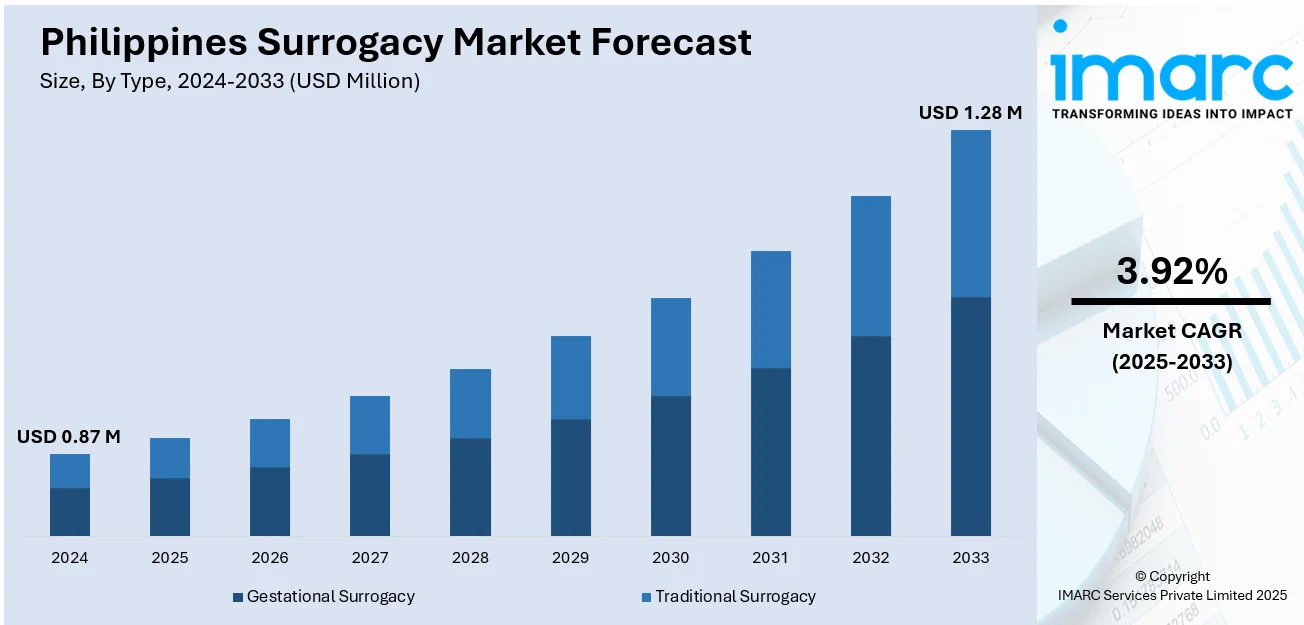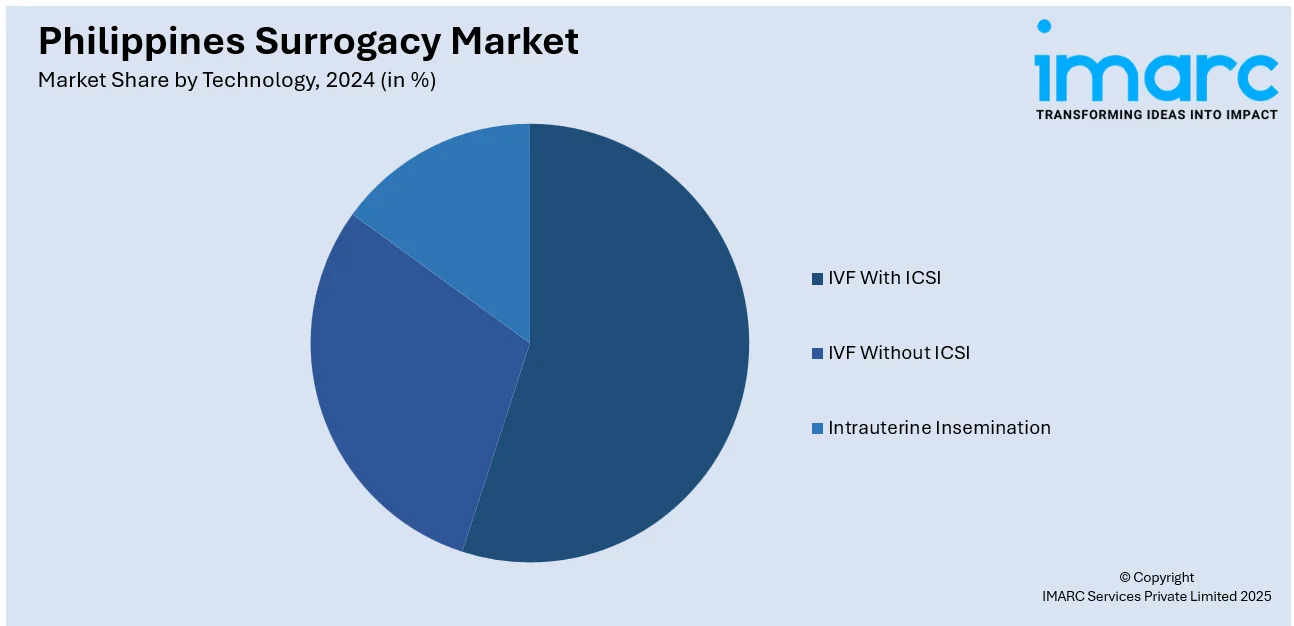
Philippines Surrogacy Market Size, Share, Trends and Forecast by Type, Technology, Service Provider, and Region, 2025-2033
Philippines Surrogacy Market Overview:
The Philippines surrogacy market size reached USD 0.87 Million in 2024. Looking forward, the market is projected to reach USD 1.28 Million by 2033, exhibiting a growth rate (CAGR) of 3.92% during 2025-2033. The market is gradually evolving, driven by rising awareness about assisted reproductive technologies, increasing infertility rates, and shifting societal attitudes toward alternative family-building methods. While ethical, legal, and cultural factors influence its growth, demand for surrogacy services is expected to expand among both domestic and international intended parents. Growing medical tourism and advances in fertility treatments also support market potential, shaping the Philippines surrogacy market share.
|
Report Attribute
|
Key Statistics
|
|---|---|
|
Base Year
|
2024
|
|
Forecast Years
|
2025-2033
|
|
Historical Years
|
2019-2024
|
| Market Size in 2024 | USD 0.87 Million |
| Market Forecast in 2033 | USD 1.28 Million |
| Market Growth Rate 2025-2033 | 3.92% |
Philippines Surrogacy Market Trends:
Growing Awareness about Assisted Reproductive Technologies (ART)
The rising awareness and acceptance of assisted reproductive technologies (ART) are significantly influencing the surrogacy landscape in the Philippines. With more couples facing infertility challenges, there is a greater openness toward exploring advanced fertility solutions like surrogacy. Educational campaigns, medical consultations, and increased exposure to global fertility practices are making intended parents more confident in pursuing such options. As awareness spreads beyond metropolitan areas into semi-urban regions, more couples are considering surrogacy as a legitimate path to parenthood. This growing demand is not only strengthening the role of fertility clinics but also pushing the market to improve transparency, affordability, and accessibility. The shift toward recognizing surrogacy as a supportive family-building method is reducing stigma and laying the groundwork for sustained expansion, making awareness a pivotal driver in shaping future opportunities.

To get more information on this market, Request Sample
Medical Tourism Influence
Medical tourism plays a key role in accelerating Philippines surrogacy market growth. The country’s reputation for skilled healthcare professionals, combined with improving fertility facilities, is attracting intended parents from abroad who are seeking more affordable options compared to Western countries. With lower treatment costs, personalized care, and increasing expertise in reproductive technologies, the Philippines is emerging as a competitive destination in the global surrogacy industry. International clients are drawn to its English-speaking medical staff and supportive environment, which ease communication and build trust. Additionally, improvements in healthcare infrastructure are positioning the Philippines as a viable choice for cross-border surrogacy services. However, legal frameworks and ethical considerations continue to shape this growth. Despite such challenges, medical tourism remains a strong opportunity, boosting both international recognition and the demand for fertility treatments in the country.
Technological Advancements in Fertility Treatments
Technological innovations in fertility treatments are driving higher success rates and instilling greater confidence in surrogacy arrangements across the Philippines. Enhanced IVF techniques, embryo freezing methods, and advanced genetic screening are reducing risks while improving outcomes for intended parents. These innovations are also allowing for better health monitoring of both the surrogate and the child, ensuring safer and more predictable procedures. As fertility clinics adopt global best practices and cutting-edge equipment, they are able to offer more reliable services to both domestic and international clients. This, in turn, strengthens the credibility of the industry and encourages more couples to consider surrogacy as a practical option. With continued integration of modern medical technologies, the Philippines surrogacy market is expected to experience steady growth, providing a competitive edge in a rapidly evolving healthcare sector.
Philippines Surrogacy Market Segmentation:
IMARC Group provides an analysis of the key trends in each segment of the market, along with forecasts at the country and regional levels for 2025-2033. Our report has categorized the market based on type, technology, and service provider.
Type Insights:
- Gestational Surrogacy
- Traditional Surrogacy
The report has provided a detailed breakup and analysis of the market based on the type. This includes gestational surrogacy and traditional surrogacy.
Technology Insights:

- IVF With ICSI
- IVF Without ICSI
- Intrauterine Insemination
A detailed breakup and analysis of the market based on technology have also been provided in the report. This includes IVF with ICSI, IVF without ICSI, and intrauterine insemination.
Service Provider Insights:
- Hospitals
- Fertility Clinics
- Others
A detailed breakup and analysis of the market based on the service provider have also been provided in the report. This includes hospitals, fertility clinics, and others.
Regional Insights:
- Luzon
- Visayas
- Mindanao
The report has also provided a comprehensive analysis of all the major regional markets, which include Luzon, Visayas, and Mindanao.
Competitive Landscape:
The market research report has also provided a comprehensive analysis of the competitive landscape. Competitive analysis such as market structure, key player positioning, top winning strategies, competitive dashboard, and company evaluation quadrant has been covered in the report. Also, detailed profiles of all major companies have been provided.
Philippines Surrogacy Market Report Coverage:
| Report Features | Details |
|---|---|
| Base Year of the Analysis | 2024 |
| Historical Period | 2019-2024 |
| Forecast Period | 2025-2033 |
| Units | Million USD |
| Scope of the Report |
Exploration of Historical Trends and Market Outlook, Industry Catalysts and Challenges, Segment-Wise Historical and Future Market Assessment:
|
| Types Covered | Gestational Surrogacy, Traditional Surrogacy |
| Technologies Covered | IVF With ICSI, IVF Without ICSI, Intrauterine Insemination |
| Service Providers Covered | Hospitals, Fertility Clinics, Others |
| Regions Covered | Luzon, Visayas, Mindanao |
| Customization Scope | 10% Free Customization |
| Post-Sale Analyst Support | 10-12 Weeks |
| Delivery Format | PDF and Excel through Email (We can also provide the editable version of the report in PPT/Word format on special request) |
Key Questions Answered in This Report:
- How has the Philippines surrogacy market performed so far and how will it perform in the coming years?
- What is the breakup of the Philippines surrogacy market on the basis of type?
- What is the breakup of the Philippines surrogacy market on the basis of technology?
- What is the breakup of the Philippines surrogacy market on the basis of service provider?
- What is the breakup of the Philippines surrogacy market on the basis of region?
- What are the various stages in the value chain of the Philippines surrogacy market?
- What are the key driving factors and challenges in the Philippines surrogacy market?
- What is the structure of the Philippines surrogacy market and who are the key players?
- What is the degree of competition in the Philippines surrogacy market?
Key Benefits for Stakeholders:
- IMARC’s industry report offers a comprehensive quantitative analysis of various market segments, historical and current market trends, market forecasts, and dynamics of the Philippines surrogacy market from 2019-2033.
- The research report provides the latest information on the market drivers, challenges, and opportunities in the Philippines surrogacy market.
- Porter's five forces analysis assist stakeholders in assessing the impact of new entrants, competitive rivalry, supplier power, buyer power, and the threat of substitution. It helps stakeholders to analyze the level of competition within the Philippines surrogacy industry and its attractiveness.
- Competitive landscape allows stakeholders to understand their competitive environment and provides an insight into the current positions of key players in the market.
Need more help?
- Speak to our experienced analysts for insights on the current market scenarios.
- Include additional segments and countries to customize the report as per your requirement.
- Gain an unparalleled competitive advantage in your domain by understanding how to utilize the report and positively impacting your operations and revenue.
- For further assistance, please connect with our analysts.
 Request Customization
Request Customization
 Speak to an Analyst
Speak to an Analyst
 Request Brochure
Request Brochure
 Inquire Before Buying
Inquire Before Buying




.webp)




.webp)












